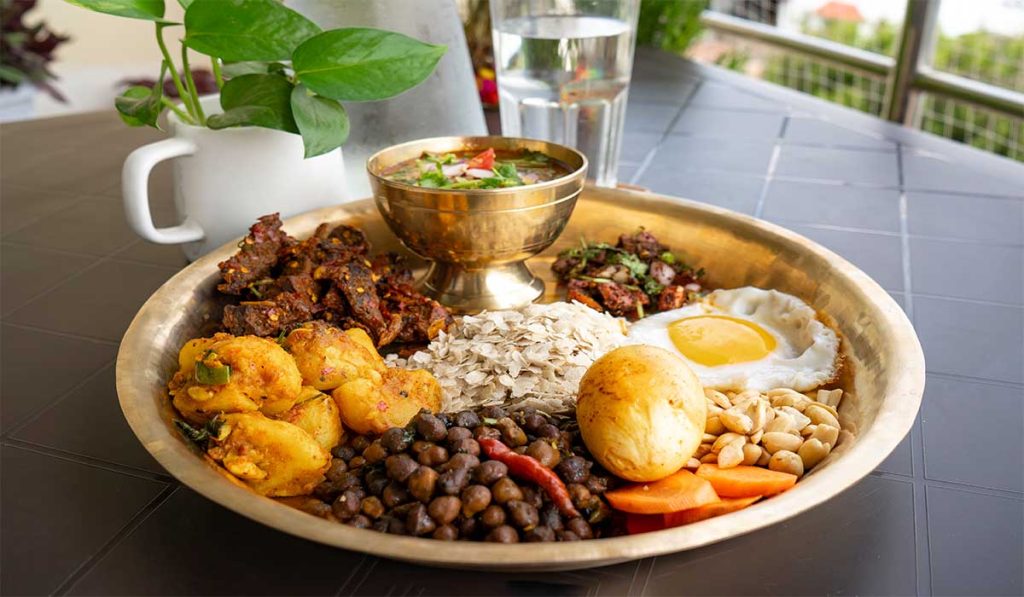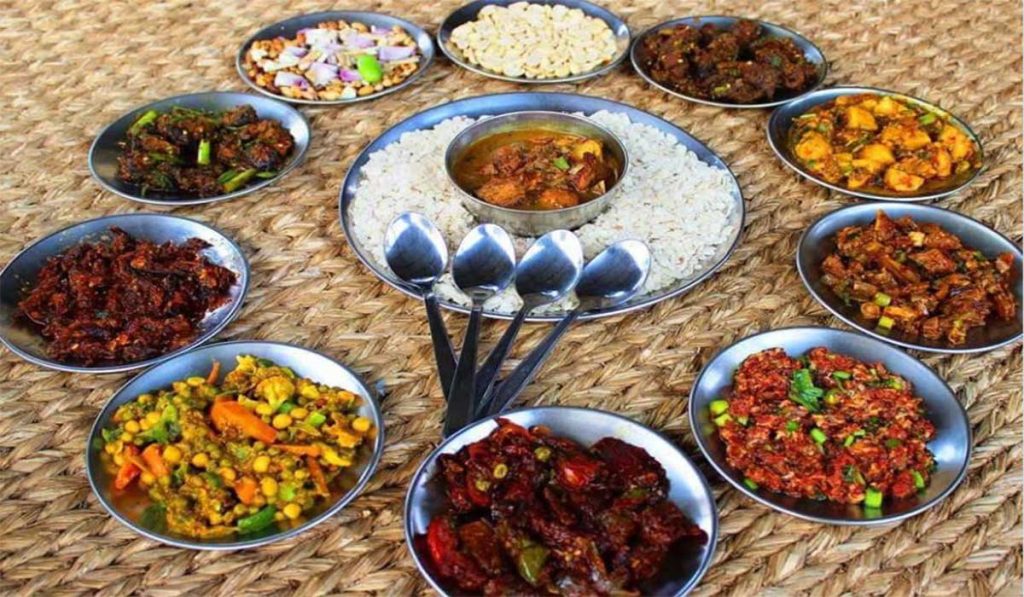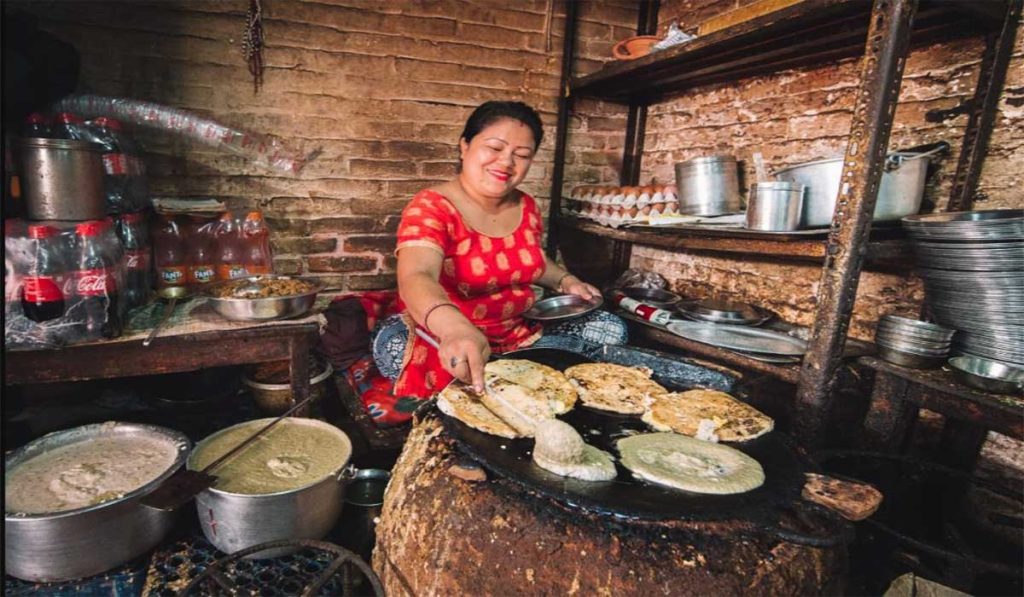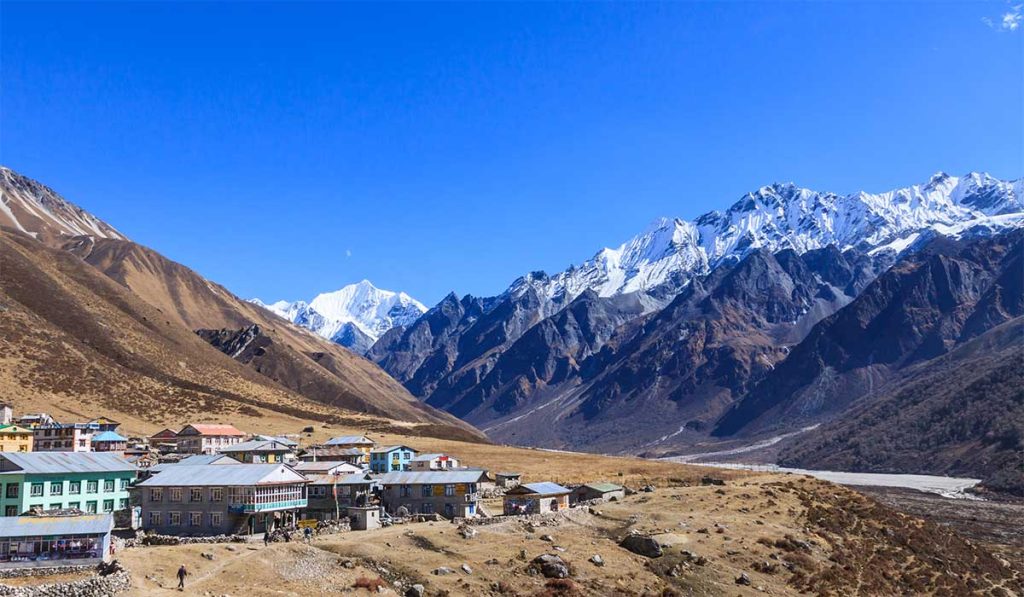Have you ever visited Kathmandu and immersed yourself in its rich Newari culture? If not, you have missed a golden opportunity to savor the authentic taste of Newari cuisine.
Kathmandu, the vibrant and culturally rich capital city of Nepal, is known for serving rich flavors of Newari culinary traditions. When you are in Kathmandu, you can experience the warm hospitality of the Newars, accompanied by their delicious dishes, which are diverse in variety and flavor.
The Newars are the oldest indigenous inhabitants of Kathmandu, and their food traditions are connected their history and culture. That is why you can expect to find different local Newari foods in different festivals and rituals they celebrate.
Interestingly, these food items are specific to those festivals.
For instance, in Yomari Punhi (a festival of the Yomari dish usually celebrated in the Full Moon of November/December), the Newars focus on Yomari. It is a rice flour dumpling, traditionally filled with chaku (molasses) or khuwa (evaporated milk solids).

Likewise, in Sithi Nakha (a festival that celebrates the value of water and sanitation, which usually falls in May/June), people consume Kwati, a mixed sprouted bean soup.
Whether it is Yomari or Kwati, or the ever-popular Bara, you will find the delicacy of these Newari dishes in many authentic Newari hotels and restaurants. The other famous Newari dishes, such as Choila, Kachila, and Chatamari, are also equally popular among locals, including Newars and non-Newars, as well as foreigners.
Meanwhile, whether you are a vegetarian or a non-vegetarian, you have plenty of options to explore from these dishes.
Famous Newari Foods You Must Try in Kathmandu
You can explore the variety of foods in Kathmandu. But, when you visit Kathmandu Valley either for business, education, or leisure, you should never miss the following Newari foods:
Samay Baji
Samay Baji is a traditional Newari dish that has been popular among people of all ages in the Kathmandu Valley. It is a platter of different food items served on various cultural occasions.
The name of the dish is made of two Newari words, ‘Samay’ meaning the time or occasion, and ‘Baji’ meaning the beaten rice. If you wish to enjoy this flavorful platter, you can try it at most authentic Newari restaurants in Kathmandu.
A set of Samay Baji comprises beaten rice, fried soybeans, boiled egg, fried fish, pickled radish, ginger and garlic, potato, aila (local alcohol ), tho (rice beer ), and choila ( spicy grilled buff or chicken). The Samay Baji is mostly served in a Lapte, a plate made by stitching leaves.
Chatamari
Chatamari is famous as “Newari pizza” amongst the foodies. It resembles pizza in its shape but is a thin rice flour crepe topped with minced meat, fried egg, vegetables, and various spices.
This dish is easy to prepare at home. But you can find it at restaurants and eateries in the Kathmandu Valley as well. The versatility of this bread is such that it can be eaten either as a snack or a main dish.
However, do not expect it to taste anything like the Italian pizza. The flavor of this is uniquely Nepali — mildly spicy, earthy, and savory. Texture-wise, it is crispy on the edges and soft in the middle. It is a delicious and balanced food that is not overwhelmingly hot.
Choila
Choila is a bold and spicy Newari dish made from grilled buffalo or chicken. The meat is marinated in mustard oil with a mix of various traditional spices, including chilies and garlic, among others.
It is traditionally grilled over a straw fire, which gives it a distinctive smoky flavor. You will find its aroma unique aroma and the appearance is charred.
Choila is also one of the main ingredients of Samay Baji. It can be consumed with Newari drinks like aila or tho. This is a must-try Newari dishes for spice lovers.
Yomari
Yomari is a traditional Newari delicacy that resembles a dumpling. It holds cultural significance as it is especially prepared during “Yomari Punhi”, a major festival celebrated by the Newars in Kathmandu. This beloved dish is widely available in authentic Newari restaurants and eateries throughout the Kathmandu valley.
Traditionally, Yomari is made from rice flour dough filled with chaku (a thick molasses-based candy) blended with ghee, nuts, and sesame seeds.
The fillings of Yomari can differ, from khuwa (milk fudge) to chocolate, melted coconut, cheese, etc. These fillings add new flavors and colors to its naturally white or light beige appearance.
Did you know? Yomari gained international recognition when Nepali chef Santosh Shah presented it on MasterChef U.K. 2020. The dish received praise and admiration from the judges. Shah reached the finale of the competition after showcasing this Newari delicacy.
Sapu Mhicha
Sapu Mhicha is a delicious Newari dish, served to honor the guests on special occasions. It is a buffalo leaf tripe stuffed with bone marrow.
The dish is visually appealing with its golden-brown or slightly darker shade and crispy exterior. Inside, the juicy and soft chewy texture makes Sapu Mhicha a delicious treat.
Juju Dhau
Juju Dhau is an iconic Newari delicacy, deeply rooted in the cultural and festive traditions of the Kathmandu Valley. “Dhau” in Newari means yogurt, and “Juju” means king. As such, Juju Dhau translates to “King of Curd”.
Like its name suggests, Juju Dhau is regarded as special among all curds thanks to its rich, creamy, and thick texture. The subtly sweet flavor makes you want to try it again and again.
You can enjoy Juju Dhau in restaurants and cafes in the Kathmandu Valley, serving Newari specialities. If you visit Bhaktapur, you will find every other shop selling this dessert.
One of the mainstays of different Newari occasions and festivals, your journey of exploring Newari cuisine becomes incomplete without trying out Juju Dhau.
Aila
Aila is a popular and distinctive traditional Newari beverage, known for its bold flavor and strong kick. It is a homemade and distilled liquor. It plays a crucial role in Newari culture, as it is an integral part of festivals and rituals.
Interestingly, the way it is served is also unique. Typically, it is poured from a traditional Newari kettle-like container into small cups or glasses.
Did you know? Aila has been recognized among the world’s top 50 most delicious drinks.
Wo
Wo is one of the distinctive and delicious Newari dishes. It is popular because of its simplicity and health benefits, and is served in many Newari feasts.
This dish can be enjoyed by both vegetarians and non-vegetarians. Mostly, it is topped with egg or meat, but it can also be served plain, as per your dietary preferences.
This deep-fried lentil patty has a golden and crispy exterior and soft interior. Wo resembles a thin pancake in shape and is typically made from ground red lentils, blended with spices like garlic and ginger juice.
Lakhamari
Lakhamari is a Newari sweet made from rice flour, butter, and sugar. It has a hard, crispy, and crunchy texture and a sweet flavor.
The traditional dish is a delightful treat in festivals like Tihar, along with weddings and other celebrations.
Bara
Bara is a beloved traditional Newari delicacy that is widely enjoyed by people of all ages. It is a fried, thick black lentil pancake, and is a main staple in Newari cuisine. You can get both the vegetarian and non-vegetarian options of Bara.
For meat lovers, Bara is topped with eggs or minced meat, while it’s served plain if you are a vegetarian.
This dish is commonly found in many hotels and eateries in Kathmandu Valley as it holds a special place in the hearts of its denizens.
Bhuttan
Bhuttan is another popular Newari dish served in almost all Newari feasts.
It can be prepared using the intestines and liver of buffalo and goat. But buffalo meat is the preferred choice for festivals and special occasions. Typically, it is served just before dessert in the Newari celebrations.
The ingredients of Bhuttan are stir-fried and seasoned with traditional spices like garlic, ginger, cumin, and chilli. This flavorful dish is loved by many, and thus, you must try it.
Kachila ( Spicy Raw Minced Meat )
Kachila is a spicy raw meat dish, especially loved by meat enthusiasts in the Newari community. It is served in many Newari festivals and special occasions.
It is prepared using fresh, raw minced buffalo meat. It is mixed with mustard oil, crushed garlic, ginger, fresh chili, and chopped coriander and served.
Wondering about the taste? You can expect for dish with a fresh, tangy, and slightly pungent flavor.
Tho
Tho is a traditional Newari rice beer. It is commonly offered to guests and also consumed during the Newari rituals, festivals, and special occasions.
It has a milky-white appearance. Its taste can vary from bitter to slightly sweet, depending on the brewer.
Moreover, it is often paired with spicy and seasoned foods to balance the flavors. But it is important that you consume this beverage in moderation, as drinking too much can also be harmful to your health.
Where to experience the Best Newari Cuisine?
Trying out Newari cuisine is an essential part of any Kathmandu tour if you want to enjoy a rich taste of the region’s culture and traditions. To truly savor the authentic flavors, you should explore with a local Kathmandu guide. As a result, the guide will introduce you to the best traditional eateries around town.
If you want to explore on your own, here are some of the top spots in the Kathmandu Valley to enjoy Newari delicacies:
- Newa Lahana, Kirtipur
- Honacha, Patan Durbar Square
- Bhaktapur Food Vendors
- Sasa Newari Restaurant, Thamel
- Yala Cafe and Coffee, Patan

Newari Cuisine in the Modern Era
Newari cuisine has been passed down from generation to generation, preserving its cultural richness. The modern generation has been giving continuity to their food cultures, embracing creativity and unique twists.
As a result, you will notice the fusion of Newari food in restaurants and cafes around town in recent days. Eventually, this has led to an increased interest in the Newari cuisine amongst food enthusiasts and vloggers.
This modern take on traditional dishes has expanded the popularity of this cuisine beyond Kathmandu Valley and internationally.
If you are also thinking of exploring famous fusions of Newari dishes, here are some innovations seen in the modern culinary scene:
- A mixture of Aila with soft drinks. The result is a cocktail where traditional aila is usually mixed with soft drinks like Mountain Dew for a fusion experience.
- Filling Yomari with the khuwa or chocolate cream instead of the classic chaku.
- Unique desserts created by mixing traditional curd with modern sweets.
Tips for Savoring Newari Foods
If you are ready to try out some local Newari dishes, then be mindful of certain things that can make a difference to your overall experience:
- The traditional Newari style of dining is by sitting cross-legged on a sukul (straw mat), and eating in leaf plates. Try this method to get the authentic experience.
- Be familiar with the Newari traditional style of eating using your hands, instead of using cutlery.
- Always pair Newari drinks like aila and tho with the seasoned spicy foods if you are open to consuming alcoholic beverages.
- Do not skip or ignore the Newari desserts and sweets.
- Never miss the Juju Dhau experience in Bhaktapur.
- Understand the significance of the Newari foods in rituals and festivals.
- Be adventurous with the meal’s texture and taste
Bara: The Pancake-like Beloved Cultural Newari Cuisine

You may have experienced pancakes many times, but when you are on a Kathmandu tour, you can see pancake-like dishes in various hotels and restaurants, which are known as “Bara”.
You must try this dish at least once on your tour as it is favourable and perfect for both vegetarians and non-vegetarians.
You can find different types of Bara. They are:
Plain Bara
Plain Bara is the perfect Newari food for every vegetarian. It is prepared with lentils and some seasonings. This dish is very famous in the Newari community and is used in the Newari feasts and occasions. It is also good for your health. Plain Bara is also known as Naglo Bara in Newari.
Anda Bara
The fried egg is added on top of the plain Bara while it is being fried. This makes the dish look more filling and attractive. Anda Bara is preferred especially by egg lovers.
Masu Bara
Minced buffalo meat is mixed in the batter of plain Bara to make the Masu Bara, meaning Bara prepared with meat. It is served in different Newari feasts and on special occasions.
Mixed Bara
Mixed Bara, as the name suggests, is a mixture of different ingredients. It is prepared by mixing minced meat and egg in the batter of plain Bara.
Look of Bara
Both the interior and exterior texture of Bara appear similar, but the taste can differ depending on the ingredients. Bara is made from soaked and peeled lentils blended with salt, spices, turmeric, garlic, and ginger. The batter is deep-fried in the form of a pancake until it forms a crispy outer layer. The inside remains soft and fluffy on the inside. The golden-brown color and crispy edges make it irresistible to try this dish at least once.
Origin of Bara and its Cultural Significance
Bara is one of the oldest and most iconic Newari dishes, believed to have originated during the ancient period in the Kathmandu Valley. The name Bara comes from the Newari term ‘Wo’, which means round or circle. It is a reference to the shape of the pancake.
Traditionally, Bara symbolizes purity, strength, and the circle of life. It was once considered sacred food offered to deities and ancestors.
The original form of Bara was the Plain Bara. Over time, the many versions of meat and egg bara developed.
In recent days, the Bara has been preserved mainly through family traditions, festivals, religious rituals, and guthi feasts. Most recently, it has been included in the menus of eateries around town, reflecting its popularity.
Instructions to prepare Bara
You can get Bara in many places in Kathmandu. But it is possible to prepare at home, too. Here are step-by-step instructions to prepare Bara at home:
- Wash and soak the black lentils overnight for about 10 hours and remove their covers.
- Grind the lentils into a smooth paste. It should not be too watery or too tight.
- Mix it with the various spices, salt, turmeric, and ginger-garlic paste. Wait for a few minutes until it gets settled.
- Heat the oil in a flat pan and grease some oil on your palm.
- Now, pour some amount of lentil paste on the heated pan and spread it into a circle. Wait until both sides are golden brown. And your Bara is ready.
- For Anda Bara, crack an egg over it and enjoy.
- For Masu Bara, add some minced meat to the batter and cook in the same manner.
Foods to Pair with Bara
If you want to elevate your experience of savoring Bara, you must try these dishes while having it:
- Aila
- Tho
- Buff curry
- Achar (pickle)
Fun Facts About Bara
- The origin of Bara dates back before Momo.
- Bara is a part of rituals and festivals.
- Bara vendors have been passing down the recipes from generation to generation.
Final Thoughts
A visit to Kathmandu is more than just scenic beauty and ancient temples. It is also a flavorful journey into the heart of Newari culture — its food culture.
Tasting the rich variety of Newari cuisine should be one of your must-do activities when in Kathmandu.
From the street food stalls to the luxury hotels and restaurants, every Newari dish tells a story of history, tradition, and culture. So, when you visit Kathmandu next time, do not forget to savor the authentic Newari foods that make your trip memorable.

